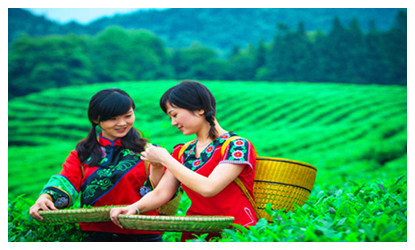Skype: neodalle-travel
Tel: +86 135 7447 2266
E-mail: sales@zhangjiajieholiday.com

 considered to have been assimilated by the Han ethnic majority. However, the Tujia people still maintain a specific cultural and social identity.
considered to have been assimilated by the Han ethnic majority. However, the Tujia people still maintain a specific cultural and social identity.
Food
Tujia people mainly eat rice as their staple food, other miscellaneous grains, such as corns, and sweet potatoes, potatoes, etc.Tujia cuisines are predominated by dishes like Tujia hot pot and tuanniancai. Tujia specialties such as ge fen (Kudzu root powder) , rice wine, cold noodles and Ciba ( a kind of pie made from Glutinous rice) are very tasty. In addition, "Tujia niancai" means that some dishes are only presented on the eve of the spring festival, including steamed meat , chicken soup with chestnuts, preserved fish, etc. Tujia hot pot is usually the favorite of all family members.
Clothing
Traditionally, Tujia women wear jackets trimmed with lace, and with short, broad sleeves. They wear long skirts, and wrap their coiled hair in cloth. They adorn themselves with necklaces, earrings, bracelets and ankle bracelets. Tujia men wear short jackets, with many buttons in front. The traditional hand-woven "xi" and "tong" cloth, with intricate designs, is the main material for clothing.
Living Quarters
The Tujia ethnic minority boasts a distinct architectural style; hanging cottages built on hillsides, and supported by pillars. The houses of the Tujia are also known as Diaojiaolou .On the lower floor, there is livestock; while the girls' bedrooms are kept upstairs. This design focuses on the use of small rooms but is also well ventilated, clean, and damp resistant.
Festivals
The grandest festival is the Tujia Year is called 'Gannian' or 'Diaonian Meeting', and is celebrated one day before the lunar New Year of the Han people. On that day, people prepare sumptuous dinners, and dance together. They also celebrate the Dragon Boat Festival, Sheri (on the second day of the second lunar month), and some others, as well. Among them, the "Diaonian Meeting", "Zhongwu Holiday", and "Guozu Festival" are the three most important holidays the Tujia people celebrate in a year.
Customs
Tujia people are well known for their custom of a crying marriage, which they view as a necessary marriage procedure. The bride may cry in different ways with diversified words, which is also called "Crying Marriage Song"; the somewhat exaggerated singing helps to enhance the wedding atmosphere. Crying at wedding is a customary way to set off the happiness of the wedding, via falsely sorrowful words.
Tujias also have some rather distinctive taboos. Young girls or pregnant women are not permitted to sit on thresholds, while men cannot enter a house wearing straw raincoats, carrying hoes, or carrying empty buckets. Nor are people allowed to approach the communal fire, or to say ostensibly unlucky things, on auspicious days.
Religious beliefs of the Tujia minority include Taoism, ancestor worship, and a shamanistic belief in gods, ghosts, and demons. Formerly, prayers were said before hunting, and when a person died, wizards were invited to expel evil spirits and ghosts from the house.
Culture & Arts of Tujia
Tujia people have their own language, which belongs to the Tibeto-Burman group of the Chinese-Tibetan language family. As they have no written script, they use Chinese characters, instead, and the large majority has come to speak the Han and Miao dialects. Tujia ethnic minority is influenced greatly by the Hans, and mainly engaged in agriculture. Diligent and courageous, the Tujias have created a colorful and unique culture and arts.
Maogusi Dance,Maogusi means "men with a lot of fur" in the Tujia dialect. The dance originated from the sacrificial ceremony of the ancient Tujia people. It's the most primitive and roughest type of Tujia Dance. Experts consider it to be a living fossil of Chinese operas. It reflects the ancient, primitive activities of the Tujias: hunting, fishing, farming, etc. All the dancers dress in clothing made from straw.
Hand-waving Dance is the most popular, ancient dance of the Tujia people. In the past, it was a kind of martial dance, used when fighting with an enemy. It lasts from the beginning of January to the 17th of the lunar calendar. Hundreds or thousands people perform the dance, all dressed in splendid attire, singing, dancing, and beating drums and gongs, at night. At these times, all Tujias are immersed in a warm and lively atmosphere.
Tujia Brocade was also named Xilan Kapu. It's made by hand and has a history of about 2,000 years. In Tujia language "Xilan" means "bedcover" and "Kapu" means "flower". So originally, Xilan Kapu is a kind of bedcover which was decorated with raised designs of flowers. It has now developed into a work of art, which takes various forms, including clothes, bags, carpets, and sachets.
 Ask Questions ?
Ask Questions ?